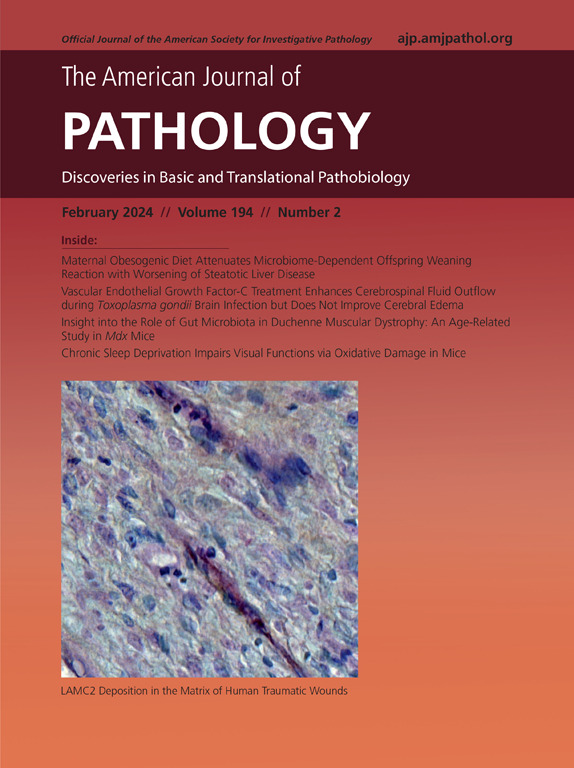Effect of Fibroblast Signaling on Macrophage Polarization
IF 3.6
2区 医学
Q1 PATHOLOGY
引用次数: 0
Abstract
Systemic and organ-specific fibrotic disorders are a leading cause of death worldwide. Crosstalk between fibroblasts and macrophages has been suggested as a key event leading to either resolution or aberrant remodeling and fibrosis. This study sought to identify the impacts of the timing and effects of exposure to quiescent (basal) and transforming growth factor-β–stimulated (activated) fibroblast-secreted products on macrophage polarization and function. Naïve (M0 macrophages), lipopolysaccharide/interferon-γ–stimulated (M1 macrophages), and IL-4–stimulated (M2 macrophages) macrophages were exposed to basal or activated fibroblast conditioned media (FBCM) for 24 hours before, after, or during macrophage polarization. Macrophage function and polarization were quantified by phagocytosis, nitric oxide, and arginase activity assays and by cytokine array. FBCM from activated fibroblasts led to a pronounced up-regulation of arginase-1 compared with that from quiescent fibroblasts in M0 macrophages. Moreover, treatment with FBCM from activated fibroblasts resulted in significant increases in arginase-1 immunoexpression as well as urea production in M2 macrophages when applied antecedent, concurrent, or subsequent to M2 macrophage polarizing cytokines. Activated FBCM enhanced several proinflammatory cytokines, such as IL-1β and IL-6, in all macrophage subsets while only increasing tumor necrosis factor-α in M1 macrophages. This study elucidates multiple proinflammatory and profibrotic effects of fibroblasts on M1 and M2 macrophages, providing insights into the complex orchestration of macrophage-fibroblast crosstalk in fibrosis and the critical role of fibroblasts in the inflammatory response to injury.

成纤维细胞信号传导对巨噬细胞极化的影响。
系统性和器官特异性纤维化疾病是世界范围内死亡的主要原因。成纤维细胞和巨噬细胞之间的串扰被认为是导致异常重塑和纤维化的关键事件。本研究旨在确定暴露于静止(基础)和转化生长因子-β刺激(激活)的成纤维细胞分泌产物的时间和效果对巨噬细胞极化和功能的影响。将Naïve (M0巨噬细胞)、脂多糖/干扰素-γ刺激(M1巨噬细胞)和il -4刺激(M2巨噬细胞)巨噬细胞在巨噬细胞极化之前、之后或期间暴露于基础或活化的成纤维细胞条件培养基(FBCM) 24小时。通过吞噬、一氧化氮、精氨酸酶活性测定和细胞因子阵列测定巨噬细胞功能和极化。与静止成纤维细胞相比,活化成纤维细胞的FBCM导致M0巨噬细胞中精氨酸酶-1的明显上调。此外,用活化成纤维细胞的FBCM处理,在M2巨噬细胞极化细胞因子之前、同时或之后,可显著增加精氨酸酶-1免疫表达以及M2巨噬细胞的尿素生成。激活的FBCM在所有巨噬细胞亚群中增强了几种促炎细胞因子,如IL-1β和IL-6,而在M1巨噬细胞中仅增加肿瘤坏死因子-α。本研究阐明了成纤维细胞对M1和M2巨噬细胞的多种促炎和促纤维化作用,为纤维化中巨噬细胞-成纤维细胞串扰的复杂协调以及成纤维细胞在损伤炎症反应中的关键作用提供了见解。
本文章由计算机程序翻译,如有差异,请以英文原文为准。
求助全文
约1分钟内获得全文
求助全文
来源期刊
CiteScore
11.40
自引率
0.00%
发文量
178
审稿时长
30 days
期刊介绍:
The American Journal of Pathology, official journal of the American Society for Investigative Pathology, published by Elsevier, Inc., seeks high-quality original research reports, reviews, and commentaries related to the molecular and cellular basis of disease. The editors will consider basic, translational, and clinical investigations that directly address mechanisms of pathogenesis or provide a foundation for future mechanistic inquiries. Examples of such foundational investigations include data mining, identification of biomarkers, molecular pathology, and discovery research. Foundational studies that incorporate deep learning and artificial intelligence are also welcome. High priority is given to studies of human disease and relevant experimental models using molecular, cellular, and organismal approaches.

 求助内容:
求助内容: 应助结果提醒方式:
应助结果提醒方式:


